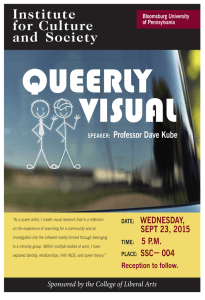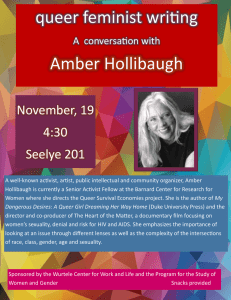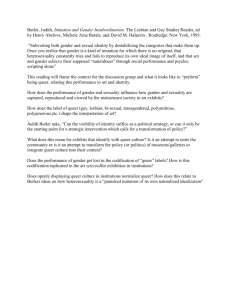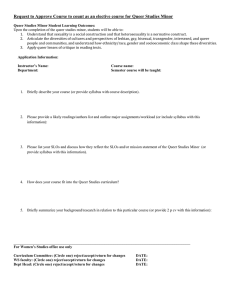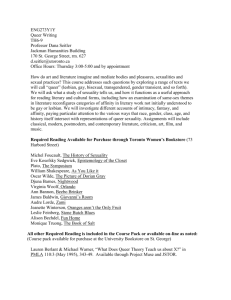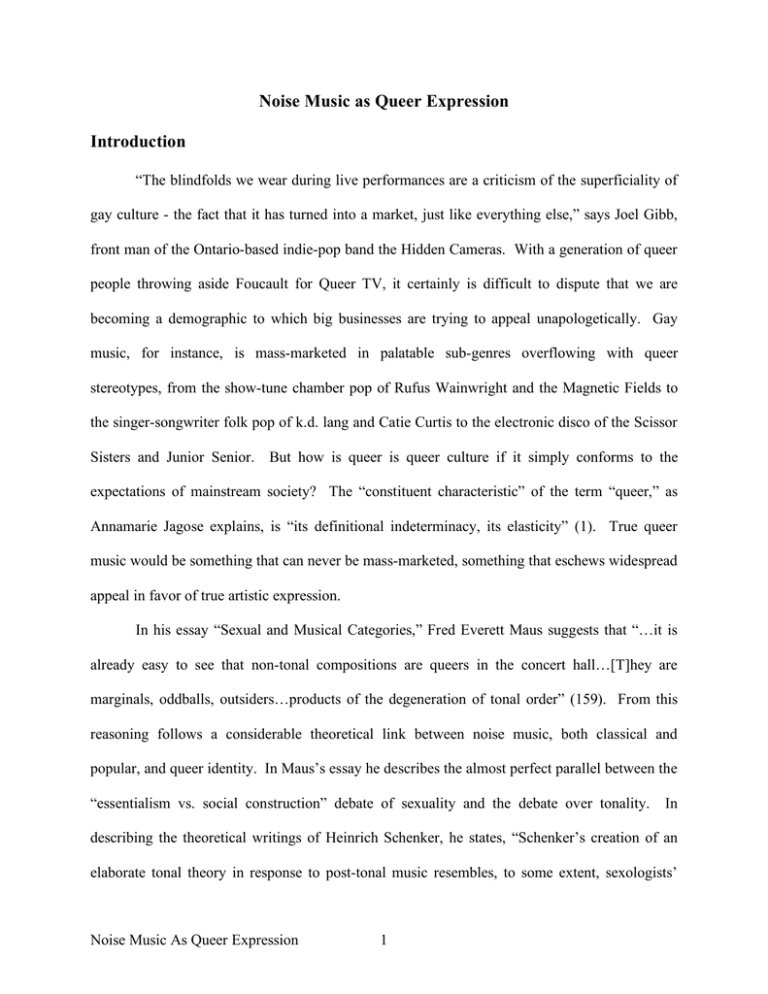
Noise Music as Queer Expression
Introduction
“The blindfolds we wear during live performances are a criticism of the superficiality of
gay culture - the fact that it has turned into a market, just like everything else,” says Joel Gibb,
front man of the Ontario-based indie-pop band the Hidden Cameras. With a generation of queer
people throwing aside Foucault for Queer TV, it certainly is difficult to dispute that we are
becoming a demographic to which big businesses are trying to appeal unapologetically. Gay
music, for instance, is mass-marketed in palatable sub-genres overflowing with queer
stereotypes, from the show-tune chamber pop of Rufus Wainwright and the Magnetic Fields to
the singer-songwriter folk pop of k.d. lang and Catie Curtis to the electronic disco of the Scissor
Sisters and Junior Senior. But how is queer is queer culture if it simply conforms to the
expectations of mainstream society? The “constituent characteristic” of the term “queer,” as
Annamarie Jagose explains, is “its definitional indeterminacy, its elasticity” (1). True queer
music would be something that can never be mass-marketed, something that eschews widespread
appeal in favor of true artistic expression.
In his essay “Sexual and Musical Categories,” Fred Everett Maus suggests that “…it is
already easy to see that non-tonal compositions are queers in the concert hall…[T]hey are
marginals, oddballs, outsiders…products of the degeneration of tonal order” (159). From this
reasoning follows a considerable theoretical link between noise music, both classical and
popular, and queer identity. In Maus’s essay he describes the almost perfect parallel between the
“essentialism vs. social construction” debate of sexuality and the debate over tonality.
In
describing the theoretical writings of Heinrich Schenker, he states, “Schenker’s creation of an
elaborate tonal theory in response to post-tonal music resembles, to some extent, sexologists’
Noise Music As Queer Expression
1
back-formation of the concept of heterosexuality” (162). He then proceeds to equate Milton
Babbitt with Foucault: “Babbitt suggested that Schenker’s theory be understood, instead, as
based on a number of axioms rather than as a natural phenomenon” (163). According to Babbitt,
traditional tonality, twelve-tonality, and atonality are all constructed ideas of musicality that lie
in some multi-dimensional spectrum with one no more natural than the other.
Similarly,
Foucault emphasizes that “Sexuality must not be thought of as a kind of natural given which
power tries to hold in check…It is the name that can be given to a historical construct” (105).
Remarkably, when “musicality” is substituted for “sexuality,” Foucault’s description of the
“great surface network” of sexualities is practically indecipherable from Babbitt’s account of
tonality (105). Like Foucault’s constructionist theory of sexuality, Babbitt’s idea recognizes the
historical invalidation of non-tonal music and denies the presumptions of naturality that underlie
it.
But while social stigma may make noise queer in the musical realm, what, if anything,
links it directly to queer sexuality? Pinpointing any specifically queer aspect of noise music is
impossible: the term “noise” is applied to such a broad variety of styles of music (rock, classical,
jazz, digital electronic, analog electronic, etc.) that finding a unifying queer motif in noise is as
difficult as finding one in all of “non-noise” music. The improvisational nature of much of noise
music makes the task even more daunting. Instead, noise empathizes with queer sexuality,
giving it twofold practicality for queer musicians and music fans.
First, it stands as an
unmarketable (and thus untainted) queer alternative to the “queer” culture being packaged and
distributed for mass consumption by mainstream heteronormative society, making it a poignant
political tool. Second, it serves as a uniquely appropriate outlet for both queer sexual expression
and the anger and despair caused by homophobia.
Noise Music As Queer Expression
2
Noise Music
While waiting in line for a Black Dice concert a few months ago, I had a nice
conversation with a lesbian couple waiting behind me about the Afrirampo and Lightning Bolt
show we had all seen over the summer. Once I was seated inside the auditorium, I met two gay
high school students who were sitting in front of me, and we talked about our shared love for
John Cage. After the opening act, I turned around to talk to the man sitting behind me about our
favorite noise rock bands. When I asked him if he liked Xiu Xiu, he said that the homosexual
imagery of the lyrics made him uncomfortable, and his gay friend a few seats down teased him
about it.
I went to a Wolf Eyes show a few weeks later and saw more of the same: a
disproportionately large portion of the audience was in some way queer. Noise music has
become one of the biggest underground musical movements over the past few years, and every
noise show I attend seems to have more and more queer people both on and off stage.
But what exactly do I mean when I say “noise music”? As previously mentioned, the
term “noise” can be used to refer to a wide variety of musical styles; the artists mentioned above
range from analog electronic (Black Dice) to noise rock (Afrirampo and Lightning Bolt) to
classical (John Cage) to noise pop (Xiu Xiu). Jagose describes the modern use of the term
“queer” as “an umbrella term for a coalition of culturally marginal sexual self-identifications”
(1). Similarly, “noise” refers to “culturally marginal” music, including discordant compositions,
free improvisations, and pieces featuring feedback and other dissonant sounds. The only truly
universal characteristic of noise music is the contextualization of sounds that are traditionally
considered non-musical into a musical setting.
Today there are countless noise artists in
different sub-genres, but even as the field grows in popularity, its harsh, unconventional nature
keeps it restricted to the underground music scene.
Noise Music As Queer Expression
3
Noise and Queer Politics
In 1993 the Kronos Quartet and Bob Ostertag released the EP All the Rage, a powerful
sixteen-minute recording that undoubtedly stands as the most direct queer political statement in
noise music. Straddling the border between musique concrète and avant-classical, the piece was,
according to Ostertag’s liner notes, “developed from a recording [Ostertag] made of a riot in San
Francisco in October 1991, which followed California Governor Pete Wilson's veto of a bill
designed to protect gays and lesbians from discrimination.” Ostertag transcribed parts of his
recording for string quartet, with the notes and sounds of the instruments recreating the sounds of
the chanting crowd, police sirens, gunshots, and breaking glass. The final piece has both the
Kronos Quartet and the recording playing simultaneously, each reinforcing the other, with
dramatic readings of the transcripts of interviews with riot participants spread throughout. This
unsettling and deeply moving piece derives much of its dramatic effect from the unexpected
musical contextualization of a non-musical recording. Television news has made us indifferent
to the violent sounds of a riot, but a gunshot once again becomes affecting when punctuated by
the sound of a violin.
This composition superficially makes an obvious political statement by highlighting the
danger and bigotry that queer people face while also depicting the undeniably human emotions
of rage and despair. Less ostensible is the political statement that the contextualization described
above makes on its own. The unconventional presentation of a riot as a musical piece is at once
shocking and upsetting: the piece does not seem to belong in the concert hall. This mimics the
feelings of rejection and disapproval experienced by queer people in homophobic society, the
exact feelings that caused the riot that the piece depicts. This singularly effective political aspect
of noise music is explored even further by many of today’s noise artists, who use it as an outlet
Noise Music As Queer Expression
4
for their frustration. This is discussed later in the paper.
By unifying a political theme with a brilliantly subtle political message in All the Rage,
Ostertag proves that he is the master of noise music as contextualization as queer political
soapbox. He took his vision even further six years later with PantyChrist, an “improvisational
collaboration” between him, Japanese noise legend Otomo Yoshihide, and San Francisco drag
queen Justin Bond. Describing the conceptualization of PantyChrist in his interview “Why I
Work with Drag Queens,” Ostertag explains that “the act of appropriation has become the
quintessential act of the late 20th century avant garde, [so] it seems only reasonable to recognize
that for drag queens this is nothing new”. Indeed, Judith Butler suggests that “Drag constitutes
the mundane way in which genders are appropriated, theatricalized, worn, and done; it implies
that all gendering is a kind of impersonation and approximation” (313). In this sense, noise
music is misunderstood for the same reasons as drag: it shows that music that relies on tone and
rhythm is as socially constructed as gender through the appropriation of non-musical elements.
By incorporating (and even apotheosizing) drag performance into his art, Ostertag generalizes
Butler’s performative theory of gender to apply to music as well.
Ostertag risked much of his reputation with PantyChrist; unlike his work with the Kronos
Quartet and luminaries such as Fred Frith and John Zorn, drag performance is not generally
considered high art. This refusal to compromise an important part of queer culture, however,
furthers Ostertag’s statement about the validity of all sexual, gender, and musical identities.
Drew Daniel and Martin Schmidt, the members of the experimental electronic duo Matmos,
follow the same philosophy as Ostertag. According to Daniel, who is also a queer theorist and
music critic, the upcoming Matmos LP features “eleven portraits of people we admire…who
were queer.” He makes an important qualification, however: “This is a political record, but it's
Noise Music As Queer Expression
5
not one that engages in the standard issue ‘give us rights because we write good books’
argument.” The two avoid the “problem [of] producing a list of illustrious gays in the hope that
we'll have this kind of forgiveness or acceptance” by including profiles of individuals such as Joe
Meek, the famous record producer who was also a murderer. Like Ostertag, they refuse to forfeit
the legitimization of those who do not conform to some lifestyle that is deemed acceptable by
mainstream society. This political statement is precisely the same one that Michael Warner uses
in his argument against the movement for same-sex marriage: “Marriage sanctifies some couples
at the expense of others. It is selective legitimization” (82).
Before Ostertag and Matmos, however, John Cage was the foremost queer noise artist.
But rather than publicly embracing his homosexuality and composing outrightly gay pieces,
Cage took a more acetic approach to queer politics. In his essay “John Cage’s Queer Silence,”
Jonathan Katz compares the “conspicuous silence” in many of Cage’s works, most notably
4’33”, with Cage’s silence about his homosexuality (50). Explaining that “Cage became notable
precisely for his silences,” Katz justifies Cage’s unwillingness to talk about his sexuality by
theorizing that Cage found silence to be more powerful than words. Perhaps surprisingly,
compositional silence can be classified as noise: 4’33” is meant to be an aleatoric piece, one that
is composed by chance through the sounds of the surroundings. Engaging the curiosities of his
fans with his ambiguous silence, Cage encouraged speculation about both the meaning of his
music and his sexuality, thus undoing preconceptions about exclusively binary systems of
musicality and sexuality.
The Queer Appeal and Evolution of Noise
Although there is clearly a considerable theoretical overlap between queer sexuality and
Noise Music As Queer Expression
6
noise music, this conceptual harmony alone cannot account for the popularity of noise music
within the queer community today. While some artists use theory as a rationale for making
political statements, what exactly is it about noise music in practical terms that could explain the
disproportionate number of queer musicians and fans in the genre? Is there some primitive
appeal, something purely entertaining about noise that draws queer fans? When I posed this
question to Drew Daniel, he gave an interesting narrative of his teenage years and his discovery
of the noise underground:
“A lot of the punk rock and hard core scene was very macho, straight-edge, and
homophobic. I drifted into noise and experimental music because it seemed more
negative, more hostile and aggressive than hard core… It was a really intensely
negative time in my life. I was a suicidal closet-case kid and noise was this ultranihilistic sound inferno that sounded really good. It was also a scene where you
had depictions of extreme sexuality… It was straight sexuality, but it was
delivered in such a brutal S&M way that it was still deviant sexuality… It was a
place where sexual deviance was being celebrated, a place where it was cooler to
be a freak, and freak could mean queer.”
For Daniel, noise music was largely a form of emotional and sexual catharsis, and in the days
before the queercore movement within punk rock, it was the only subversive musical community
that would accept his homosexuality. The ability to identify not only with the musicians and
their lyrics but also with the non-normative nature of their music gave Daniel what he could not
find elsewhere.
The nature of noise performance and its relevance to the queer community underlies
Daniel’s story. In her essay “Tragic Misreadings: Queer Theory’s Erasure of Transgender
Noise Music As Queer Expression
7
Subjectivity,” Ki Namaste expounds her theory of performance as a reinforcement of a presumed
normalcy by the audience: “The limiting of drag queens to the stage also suggests that drag is
something you do; it is not someone you are… Drag is about performance while the homoerotic
is about identity” (186-187). This cannot be true in the case of noise performance, however,
where the audience is as actively engaged in the sonic bombardment as the performer, where
there can be no “limiting to the stage” of anyone. This is not to say, however, that Namaste’s
perspective is not informative here. Indeed, it becomes quite useful when the performer and the
audience are viewed as a unified entity, which is the ultimate goal of noise.
Then the
performance is no longer about objectification of the performer but rather about identification
with the performer, identification through the shared sonic experience of the performance and the
common life experiences expressed in the music.
Daniel explains that “most of the noise shows that [he] went to in the 80's were the same
old macho boy’s club, because it was about showing that you were tough enough to take the
really hellish noise.” In the wake of the short-lived no-wave movement, noise was no longer
restricted to the realm of avant-classical in the early 80’s, and the band Whitehouse emerged as
the first power electronics group.
While the misogyny and violent (hetero)sexuality of
Whitehouse’s songs (“A Cunt Like You” and “I’m Comin’ Up Your Ass”, for example) may
have been immediately accessible to the “boy’s club” that Daniel describes, the pioneers of
industrial music, Throbbing Gristle, challenged that notion entirely. The noise scene could not
possibly remain a haven for heterosexist men when this group, which included the overtly
homosexual Peter Christopherson and the self-described “pandrogynous” Genesis P-Orridge,
rose to eminence. While the sound of Throbbing Gristle was very similar to that of Whitehouse,
audiences now had to identify with the lyrics of “Can the World Be as Sad as It Seems?” and
Noise Music As Queer Expression
8
“United,” which describe cross-generational gay sex and a sadomasochistic polyamorous
relationship. Finally, Coil broke onto the scene, combining music that surpassed even the
harshness of Whitehouse with lyrics based almost entirely upon the duo’s Satanic homosexual
practices (see “The Anal Staircase” and “Penetralia”).
By the mid 80’s, two of the three biggest noise groups embraced graphically queer
sexuality in their music. Because of the necessity of identification with noise performance, the
noise scene became the perfect environment for, as Daniel puts is, “a certain kind of queer
person who isn't sold on the ‘fitting in at all costs, being presentable to middle America,
politically efficacious’ mainstream route.” The “boy’s club” began to break down as noise
shows became much more of a home for queers than for misogynistic, heterosexist men. This
was the perfect environment for the second wave of noise in popular culture, the so-called
“Japanese Invasion.” While Merzbow made the loudest, most pummeling industrial electronic
noise yet on albums such as “Ecobondage” and “Music For Bondage Performance,” the
Boredoms challenged the structures of punk rock, pop music, and noise with songs such as the
epic trilogy of “Anal Eater,” “God from Anal,” and “Born to Anal,” which enthusiastically
featured the sounds of various bodily functions.
So how exactly did the queer noise scene evolve in this way? Did the music make
heterosexual noise fans begin to question their sexuality and explore other sexual practices, or
did the overwhelming homosexual and queer themes of noise music in the late 80’s and early
90’s simply attract queer fans? In other words, was this change a natural evolution or simply a
reclaiming of queer territory? While the latter was clearly the case for Daniel, it is impossible to
know exactly what the overall trend was. At the same time, asking about the sexuality of noise
fans is not entirely productive, as it loses us in the same loop of inversion that Judith Butler
Noise Music As Queer Expression
9
describes for sexuality in general: “The entire framework of copy and origin proves radically
unstable as each position inverts into the other and confounds the possibility of any stable way to
locate the temporal or logical priority of each term” (313). The only clear conclusion to be
drawn is that popular noise music is indeed a growing phenomenon with broad appeal to queer
musicians and fans alike.
Noise as a Queer Outlet
Beyond identification, Daniel also describes noise as an outlet for emotional and sexual
frustration. While these forms of catharsis are not exclusively available to the queer community,
there are few outlets for frustration toward heterosexist society and queer sexual energy that are
as naturally queer as noise music. Ostertag’s All the Rage is an obvious example of using noise
to release outrage, but there are countless others.
For example, Jamie Stewart’s noise-pop project Xiu Xiu illustrates perfectly how noise
can be channeled to express and ease pain and anger simultaneously. Many of Stewart’s songs
are biographical tributes to the lives of people he has known who have been abused by
heterosexist society, using noise as an auditory representation and release of overwhelming
emotions. In the song “Dr. Troll,” for example, Stewart sings about a male-to-female transgender
teenager who “holds inside of her the horrible dream of being somebody” and “pretend[s]
someone could love [her].” A caterwauling screech of feedback dominates the track as we learn
that her life “would be so much easier if she was [sic] a real girl.” Her dream is horrible because
it is unachievable, and appropriately we are faced with horrible sounds that represent her
anguish. Similarly, wailing synthesizers roll over decomposing drums as Stewart’s distorted
voice howls “A-I-D-S, H-I-V! I cannot wait to die, can’t you tell?” in “Hives Hives,” a song for
Noise Music As Queer Expression
10
a patient in an AIDS clinic where Stewart worked who spent his last days filled with sarcastic
acceptance of death and overwhelming regret about what he never accomplished. Meanwhile,
Stewart addresses his own past in “Yellow Raspberry,” telling himself, “you became a faggot
just like a bunny, beating of nonstop to the Escort pages,” while shrill, squealing electronics
layer themselves over a tribal drum beat. Although it may initially seem like a disavowal of
queer sexuality, this song is instead an expression of Stewart’s disapproval for the highly
superficial and over-commercialized lifestyle that he feels is difficult for queer men to escape
today. While the stories behind Stewart’s songs never come to a pleasant or even satisfying
conclusion, we still feel the catharsis he intends us to feel through his beautifully climactic noise
arrangements.
On the other hand, noise is also employed positively as a form of sexual expression, as
we have seen in the sadomasochistic Merzbow pieces and the ritualistic homosexual
compositions of Coil. Reinhold Friedl points out that “in his concerts [Merzbow] uses noise
levels of over 110 dB, well past the pain threshold of the listeners” (30). This is undoubtedly a
sadomasochistic act. A more direct example, however, is Afrirampo, a recently formed guitarand-drums noise duo from Japan. The two describe their music as “naked rock” and “so fucking
sexual,” and their records and live performances unequivocally verify this claim. Appearing on
stage in their “strong red dress” or sometimes nothing but red paint, Oni and Pika harness their
sexual energy in songs such as “Want You,” where they declare their heartfelt desire for each
other in beautifully painful shrieks over a mutilated traditional blues melody, and “Hadaka,”
where their simultaneous orgasmic shouts ring over mountains of squalling guitar feedback,
discordant riffage, and drum-pummeling.
Avant-garde composer Pauline Oliveros states that her motivation for composing music
Noise Music As Queer Expression
11
is the “pleasure, ecstasy, and euphoria” that comes from listening to her pieces being performed.
Meanwhile, when music critic Martha Mockus listens to Oliveros’s Rose Mountain Slow Runner,
she finds “the stories of lesbian erotic exchange sounded out” in the breaths of the singers and
the accordion bellows. In the 1983 recording of Horse Sings from Cloud, Oliveros performs the
piece with Heloise Gold, Julia Haines, and Linda Montano, the latter being Oliveros’s lover at
the time. As Dolores Hajosy explains in the liner notes, “The listeners may tune into the
different breathing patterns of each instrument…The instruments and vocalizations combine to
create a rich phasing of breath cycles.” The “shimmering” dynamic between the deep bass of
Oliveros’s bandoneon and the soprano voice of Montano’s concertina establish the butch-femme
relationship that Mockus also identifies, with the breathing patterns of the instruments
representing sexual vocalizations. The pleasure of listening then, is coupled with the pleasure of
reenacting sexual encounters, and music and sex become unified in the performance. This notion
follows Foucault’s idea of the confession as an erotic practice: “In the Christian
confession…there was a whole series of methods that had much in common with erotic art…
[including] the intensification of experiences extending down to their physical components” (70).
Oliveros’s brand of classical music, then, falls under the label of ars erotica, and serves as a
perfect example of the expression of lesbian sexuality through noise.
Conclusions
Noise music has emerged as an occluded part of queer culture. Existing as a queer (i.e.
marginal) form of music, noise suffers from and reflects the same misconceptions and prejudices
that surround queer sexuality, making it a perfect medium for the expression of queer political
statements, such as those of Bob Ostertag, Matmos, and John Cage. Its marginal existence and
Noise Music As Queer Expression
12
subversive content, including the sexually explicit material of Throbbing Gristle and Coil, attract
many queer musicians and music fans to the scene. These artists then use noise as a means of
expressing mental and sexual frustration through its harsh yet cathartic sounds, as demonstrated
in the work of the Kronos Quartet, Afrirampo, Xiu Xiu, and Pauline Oliveros. While there is
nothing specifically relevant to queer sexuality that unites all noise music, it is in fact a subculture with a history that is very familiar to queer musicians, one that is a safe haven for queer
expression, be it for the purpose of advancing a political movement or simply for the purpose of
entertaining each other.
References
Afrirampo. Interview. Panache Magazine. Issue 22.
Butler, Judith. “Imitation and Gender Insubordination.” The Lesbian and Gay Studies Reader.
Ed. Henry Abelove et al. Routledge: New York, 1993.
Daniel, Drew. Telephone Interview. 4 December 2005.
Foucault, Michel. The History of Sexuality: An Introduction, Vol. 1, transl. Robert Hurley.
Vintage Books: New York, 1990.
Friedl, Reinhold. “Some Sadomasochistic Aspects of Musical Pleasure.” Leonardo Music
Journal, Vol. 12, 2002.
Gibb, Joel. Telephone Interview. 20 November 2005.
Hajosy, Dolores. In The Wanderer [LP liner notes]. Lovely Music: New York, 1984.
Jagose, Annamarie. Queer Theory: An Introduction. NYU Press: New York, 1997.
Katz, Jonathan D. “John Cage’s Queer Silence; or, How to Avoid Making Matters Worse.”
Writings Through John Cage’s Music, Poetry, and Art, Ed. David W. Bernstein and
Noise Music As Queer Expression
13
Christopher Hatch. University of Chicago Press: Chicago, 2001.
Maus, Fred Everett. “Sexual and Musical Categories.” The Pleasures of Modern Music, Ed.
Arved Ashby. University of Rochester Press: Rochester, NY, 2004.
Mockus, Martha. Abstract: “Respiration: Breathing and Sounding a Lesbian Musical Valentine.”
Society for Music Theory 22nd Annual Meeting. Atlanta, GA, 13 November 1999.
Namaste, Ki. “Tragic Misreadings: Queer Theory’s Erasure of Transgender Subjectivity.”
Queer Studies: A Lesbian, Gay, Bisexual, and Transgender Anthology. Ed. Brett
Beemyn et al. NYU Press: New York, 1996.
Ostertag, Bob. In All the Rage [CD liner notes]. Nonesuch Records: Los Angeles, 1993.
----- Telephone Interview. 17 December 2005.
----- “Why I Work with Drag Queens.” Die Wochenzeitung, Zurich. 26 March 1999.
Stewart, Jamie. Telephone Interview. 8 December 2005.
Warner, Michael. The Trouble with Normal. Harvard University Press, Cambridge, 2000.
Xiu Xiu. Knife Play. 5 Rue Christine: Olympia, WA, 2002.
----- La Forêt. 5 Rue Christine: Olympia, WA, 2005.
Noise Music As Queer Expression
14
MIT OpenCourseWare
http://ocw.mit.edu
WGS.110 Sexual and Gender Identities
Fall 2010
For information about citing these materials or our Terms of Use, visit: http://ocw.mit.edu/terms.

